Scarborough Board of Education


The Scarborough Board of Education (SBE, commonly known as School District 16), formally the Board of Education for the City of Scarborough is the former public-secular school district serving Scarborough, Ontario, Canada. The board was founded in 1954 through a merger of the Scarborough Collegiate and Township School Boards.
As of 1996, the SBE had served over 81,000 students and 8,300 employed staff. It was the largest school board in the former Metro Toronto.[1]
In 1998, the SBE was merged into the Toronto District School Board.[2] The former SBE offices in Borough Drive. remain in use today by the TDSB as the East Education Office.
History
[edit]This section needs expansion. You can help by adding to it. (October 2013) |
Scarborough's first schools were built in Hough's Corners, West Hill, Woburn, L'Amoreaux and Finch /McCowan. Later in 1914, three more schools in Southwest Scarborough, Scarborough Village and Agincourt were built.[3]
In need for secondary education, Agincourt Continuation School was established in 1915 in the elementary school building while senior grades were done in Markham District High School. However, by 1919, many students in south Scarborough had attended Malvern Collegiate Institute in East Toronto, which became a reality in 1922 when Scarboro High School opened its doors with classic specialist Dr. Reginald H. King as principal, three teachers and 116 pupils.[3]
By the early 1940s the public school inspector for Scarborough, H. A. Halbert, initiated a movement to amalgamate these small school sections to form Township School Areas known as the Scarborough Township Public School Board, each with a Board of five Trustees, which would be better able to meet Scarborough's modern educational needs.[3] Between 1944 and 1947, the township board was divided into three areas:
- Area 1: Southwest Scarborough (School sections 10, 12, 13, 15)
- Area 2: Central Scarborough (School sections 7, 8, 9, 16 – Area 6 joined in 1953)
- Area 3: North Scarborough (School sections 5 and 14)
Towards the end of 1953, there were 32 schools with 13,227 students and 356 teaching staff.[3]
On January 1, 1954, The Collegiate and Township Boards merged into the new Scarborough Board of Education. Dr. King, the principal of Scarborough C.I. became the first Director of Education.[3] As the architecture of these new schools was simple, functional and unpretentious, the earlier models were sometimes subject to criticism as bearing too close a resemblance to long, low factory buildings. However, as school succeeded school, their style and appearance was progressively improved. In some of the more recent buildings marks of beauty and distinction have begun to emerge. Indeed, to the eyes of older Scarborough residents accustomed to the bare little brick schoolhouses of the rural period, the latest modern school buildings of gleaming glass, steel, and brick are most impressive temples of learning. To attractive well-lighted classrooms have been added new features: beautiful kindergarten classrooms with radiant heating in the floors, libraries, manual training and household science rooms, rooms for nurses and teachers, spacious dual purpose gymnasiums and auditoriums with stages, and modern equipment such as motion picture projectors, tape recorders and even television sets. Many children are also transported daily to school in school buses; which ends the era of the day of the long walk to school in wind and rain, snow, mud and dust conditions.[3]
With overcrowding at Scarborough Collegiate Institute and Agincourt High School, they were incapable of coping with the crowds of students seeking secondary education.[3] This led to the construction of its third high school Winston Churchill Collegiate Institute, named after Winston Churchill, on Kennedy and Lawrence in the Dorset Park area on December 4, 1953, with the first 657 pupils admitted on September 7, 1954.[3] One year later, West Hill Collegiate Institute on Morningside Avenue in West Hill opened on September 6, 1955, to 376 students.[3] That year it was also necessary to enlarge Agincourt Collegiate Institute by the addition of seventeen rooms and a gymnasium.
Then followed in rapid succession the building of four more great secondary schools to meet the need for accommodation for 1,200 more students each year. In 1958, W. A. Porter Collegiate Institute –whose school named after the science master and assistant principal of Scarborough's first High School for many years from its opening in 1922 – was completed on Fairfax Crescent in the Clairlea district. To it was later added a notable new feature, an indoor swimming pool, the first of its kind in Scarborough. In 1959, the David and Mary Thomson Collegiate Institute, a 1,200 pupil school costing $1,728,400.00, was constructed on Lawrence Avenue a short distance west of the first settler's home in the forests of 1796.[3]
Next in 1960, the SBE's most ambitious venture in secondary education, the huge Cedarbrae Secondary School, was built at a cost of over $3,500,000.00, on the hillside overlooking the site of Peter Secor's grist mill of 1830, on the west side of the Markham Road. Designed as a composite school, it offered a wide variety of courses, Arts and Science, Commercial, Technical and Trades; and it included well equipped vocational shops, gymnasiums, swimming pool, auditorium with professionally lighted and curtained stage, and numerous other modern school facilities. The school was opened in September 1961. However, its eighth composite secondary school, Midland Avenue Secondary School opened in 1962. Like Cedarbrae, the school was equipped with an auditorium with seats, large rounded circular cafeteria, triple gymnasium, swimming pool and several commercial and technical shops.[3]
The combined enrollment of 11,470 students and a staff of 526 teachers in eight collegiate institutes and the construction of yet more schools was in progress. On Ellesmere and Markham the basic high steel framework and long brick walls of the great new Woburn Collegiate Institute were rising behind the little red brick schoolhouse of 1863, from whose belfry had rung the call to classes that took generations of pupils from the farms of School Section No.6. The new Woburn C.I. admitted its first students the next autumn; and on Midland Avenue and Lawrence, Bendale Vocational School, planned especially for the benefit of students who normally drop out of school before completing Grade 12 or even 10, was also opened in 1963. The next year, 1964, Birchmount Park Collegiate Institute, built on the ridge overlooking Birch Cliff – which was once the shore of Lake Iroquois in ancient glacial times – and is attached to Birchmount Stadium, and the Sir John A. Macdonald Collegiate Institute (formerly O'Sullivan Secondary) on Pharmacy Avenue north of Sheppard, were completed.
Above the great bluffs towering up from the lake at Guildwood Village, where land once sold for six York shillings or seventy-five cents an acre in 1803, the Board of Education acquired fourteen and one-fifth acres at a cost of $303,700 for another school, and there the building of the Sir Wilfrid Laurier Collegiate Institute was begun in the latter part of 1964. At the beginning of 1965, on Midland Avenue north of Eglinton, the walls of the Tabor Park Vocational School, named after one of Scarborough's early schoolmasters, were built up to the second story; and work on the new Wexford Collegiate Institute on Pharmacy Avenue north of Lawrence was well advanced. There were now 15,000 students enrolled in Scarborough's secondary schools, and 761 teachers on the staff.[3]
The SBE in September 1968, found itself responsible for the education of about 78,000 students, enrolled in more than 100 elementary and secondary schools. Some schools were surrounded by as many as 10 and 12 portables, and the total number of such temporary classrooms in use was 257. But while called on to wrestle continually with the accommodation issue, a building programme which never quite catches up with the spiralling growth of the Borough, and a budget requiring a tax levy of nearly 40 million dollars, the Board of 1968 still finds time to escape from the rut of routine business and explore new ground. Under the far-sighted leadership of its chairman, Muriel A. Clarke, and the dynamic Director of Education, Anson S. Taylor, the Board introduced a concept of new tri-level system of together with a Secondary School on a common campus. One such campus is now in operation in the Bendale Secondary School area; and a yet more imaginatively conceived three-school community was under construction on the Stephen Leacock Collegiate Institute site on Birchmount Road north of Sheppard Avenue as well as Sir Oliver Mowat Collegiate Institute on Lawrence and Centennial in Rouge Park. Both schools were opened in 1970. Its keen interest in training for young people unable to progress academically beyond public school still continues; and another well equipped Vocational School, three and a half million dollar Maplewood Vocational School, was opened in 1968 despite a year delay on Galloway Road in West Hill. However, in 1966, Sir Robert L. Borden Secondary School opened its doors.[3]
By the beginning of the 1970s, the Scarborough community began to develop. In 1973, L'Amoreaux Collegiate Institute, located near School Section No. 1, was built on Warden and Finch and designed by Raymond Moriyama. The school was built with a forum and cafetorium in place of the auditorium to save costs. By 1976, Albert Campbell Collegiate Institute was opened on Finch and McCowan. This was followed by the three-level Lester B. Pearson Collegiate Institute in 1978 in the Malvern district and its final collegiate Dr. Norman Bethune Collegiate Institute, on the Warden/Steeles area, was opened in 1979. Meanwhile, two more technical schools, Timothy Eaton Secondary School, named after Timothy Eaton was opened on Finch and Warden in 1971 and Sir William Osler Vocational School was opened on Huntingwood and Midland in Agincourt in 1975.
As of 1985, there were over 160 elementary schools and 25 secondary schools.
In the first of its kind in Scarborough, inspired by George S. Henry Academy, the SBE had converted R. H. King Collegiate Institute into R. H. King Academy in September 1989. The new academy functioned as a quasi-private school enrolling students from out of area and the school featured clinics, mentorships and mandatory school uniforms.
In 1992, the SBE and the Centennial College made a deal to establish an adult education centre, the Scarborough Career Planning Centre, at the Centennial College.[4] In 1994 the entities agreed to establish the centre there beginning in the fall of that year.[5]
Plans were made to conduct the Scarborough Alternative For Educating Troubled Youths (SAFETY) program in 1994. The program was designed for students with twenty-day suspensions, the maximum period possible, in the former Highbrook Senior Public School facility. Community protests put these plans on hold and were never materialized.[6] Currently, the SAFETY program was later evolved into the TDSB's Caring and 'Safe School' programs.
On December 31, 1997, the SBE, as with the other school boards in Metro Toronto, was dissolved. The board was merged into the new Toronto District School Board the following year.
Organization
[edit]The Scarborough Board of Education, at its peak, had 14 elected trustees with three delegates from the Metropolitan Separate School Board as of 1985.[citation needed]
Following provincial legislation directing amalgamation of the Scarborough Board with the other boards making up the old Metro Toronto School Board (Toronto, North York, East York, Etobicoke and Scarborough) the last meeting of the SBE was held on November 27, 1997, chaired by Mrs. Gaye Dale, Trustee of Scarborough Ward 1 and chairman of the board.[citation needed]
Schools
[edit]Scarborough's schools were built from the 1940s to 1960s. Older 19th- and 20th-century school houses were demolished to make way for large buildings as the area grew.
On the north end of the city schools were built from the 1960s to 1980s.
At one time the board operated educational programs for Francophone students. The Conseil des écoles françaises de la communauté urbaine de Toronto (CEFCUT) assumed control of French-language education in the Toronto area on 1 December 1988.[7]
Elementary schools
[edit]Junior Public Schools (and mixed)
[edit]From 1968 to 1980s, many existing Kindergarten to Grade 8 schools were redesignated as Junior Public School, targeting pupils ages 4 to 12 from kindergarten to grade 6 only.
| Name | Opened | Notes | Image |
|---|---|---|---|
| Donwood Park Public School | 1956 |
|

|
| Walter Perry Junior Public School | 1954 |
|

|
| Iroquois Junior Public School | 1969 |
|
|
|
North Brimwood Junior Public School |
1966 |
|

|
| Norman Cook Junior Public School | 1953 |
|

|
| St. Andrews Public School | 1959 |
|

|
| Anson S. Taylor Public School | 1977 |
|
|
| John A Leslie Public School | 1923 |
|

|
| Terry Fox Public School | 1981 |
|
|
| Hillside Public School | 1855 |
|
|
| Oakridge Junior Public School | 1967 |
|
|
| West Rouge Junior Public School | 1954 |
|
|
| William G Davis Junior Public School | 1967 |
|
|
| Centennial Road Junior Public School | 1946 | ||
| Charlottetown Junior Public School | 1967 |
|
|
| Chester Le Public School | 1972 | ||
| Fairglen Public School | 1966 | ||
| Beverly Glen Junior Public School | 1972 | ||
| David Lewis Public School | 1990 |
|
|
| Brookmill Boulevard Public School | 1975 | ||
| Bridlewood Public School | 1966 |
|
|
| Timberbank Public School | 1969 | ||
| Pauline Johnson Public School | 1969 |
|
|
| Kennedy Public School | 1988 |
|
|
| Silver Springs Public School | 1975 |
|
|
| Highland Heights Public School | 1967 |
|
|
| Port Royal Public School | 1992 |
|
|
| Milliken Public School | 1982 |
|
|
| Alexmuir Public School | 1973 | ||
| Chartland Public School | 1968 | ||
| North Agincourt Public School | 1957 |
|
|
| C.D. Farquharson Junior Public School | 1954 |
|

|
| Agnes MacPhail Public School | 1980–1981 |
|
|
| Macklin Public School | 1988 |
|
|
| Tom Longboat Public School | 1978 |
|
|
| Malvern Public School | 1977 |
|
|
| Heritage Park Public School | 1994 | ||
| Alexander Stirling Public School | 1984 |
|
|
| Berner Trail Public School | 1973 |
|
|
| Grey Owl Public School | 1975 |
|
|
| Emily Carr Public School | 1980 |
|
|
| Fleming Public School | 1990 |
|
|
| Maryvale Public School | 1955 | ||
| Wexford Public School | 1951[15] |
|

|
| Vradenburg Public School | 1955 |
|
|
| Buchanan Public School | 1954 | Built on land farmed by Buchanan family c. 1830. | 
|
| Manhattan Park Junior Public School | 1956 |
|

|
| George Peck Public School | 1955 |
|

|
| Inglewood Heights Public School | 1956 |
|
|
| Lynngate Public School | 1960 | ||
| Ellesmere Junior Public School | 1951 | 
| |
| Dorset Park Public School | 1954 |
|

|
| General Crerar Public School | 1954[19] |
|

|
| Ionview Public School | 1953 |
|

|
| Lord Roberts Junior Public School | 1958 |
|

|
| Hunter's Glen Junior Public School | 1956[20] | 
| |
| Glen Ravine Junior Public School | 1956 | 
| |
| Edgewood Public School | 1958 |
|

|
| Knob Hill Public School | 1956 |
|

|
| McCowan Road Junior Public School | 1954 |
|

|
| Pringdale Gardens Junior Public School | 1963 |
|

|
| Cedarbrook Public School | 1958 |
|

|
| White Haven Public School | 1968 | ||
| Bendale Junior Public School | 1957 |
|

|
| North Bendale Junior Public School | 1960 |
|

|
| Bellmere Junior Public School | 1965 |
|

|
| William Tredway Junior Public School | 1956 |
|

|
| Woburn Junior Public School | 1964[26] |
|

|
| Churchill Heights Public School | 1957 | 
| |
| Golf Road Junior Public School | 1953 |
|

|
| Cornell Junior Public School | 1954 |
|

|
| Willow Park Junior Public School | 1964 | 
| |
| Heather Heights Junior Public School | 1959 |
|

|
| George B. Little Public School | 1957 |
|
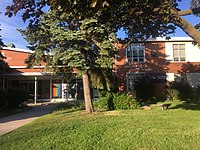
|
| Burrows Hall Public School | 1974 |
|
|
| Lucy Maud Montgomery Public School | 1970s (~1972) |
|
|
| Brooks Road Public School | 1970 | ||
| Military Trail Public School | 1970 |
|

|
| St. Margaret's Public School | 1972 | ||
| Galloway Road Public School | 1958 | Named for local Galloway. | |
| Eastview Public School | 1955 | ||
| Morrish Public School | 1989–1990 |
|
|
| Highland Creek Public School | 1918 |
|
|
| West Hill Public School | 1994 |
|
|
| Heron Park Public School | 1949 |
|
|
| Peter Secor Public School | 1962 |
|
|
| William G Miller Public School | 1959 |
|
|
| John G. Diefenbaker Public School | 1980–1981 |
|
|
| Meadowvale Public School | 1953 |
|
|
| Rouge Valley Public School | 1992 | ||
| Regent Heights Public School | 1921 |
|
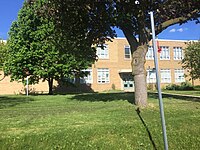
|
| Warden Avenue Public School | 1952 |
|

|
| General Brock Public School | 1956 |
|

|
| Danforth Gardens Public School | 1957 | ||
| Birch Cliff Public School | 1916 |
|
|
| Birch Cliff Heights Public School | 1922 |
|
|
| Corvette Junior Public School | 1954 | Named for Royal Canadian Navy's Flower-class corvettes from WWII | 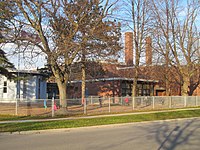
|
| J. G. Workman Public School | 1949 |
|

|
| Cliffside Public School | 1952 |
|
|
| Chine Drive Public School | 1956 | 
| |
| H.A. Halbert Junior Public School | 1951 |
|

|
| Fairmount Public School | 1951 |
|
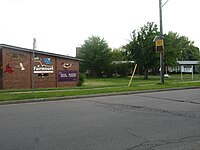
|
| Mason Road Junior Public School | 1957 | 
| |
| Anson Park Public School | 1959 | 
| |
| Cedar Drive Junior Public School | 1970 | 
| |
| George P Mackie Public School | 1954 |
|
|
| Elizabeth Simcoe Public School | 1963 |
|
|
| Guildwood Village Public School | 1959 | ||
| Poplar Road Public School | 1960 | ||
| Courcelette Public School | 1958 |
|
|
| Thomas L. Wells Public School | 2005 |
|
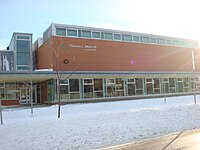
|
| Brookside Public School | 2007 |
|

|
| Alvin Curling Public School | 2013 |
|
|
| Harold R. Lawson School | 1963–1964 |
|

|
Senior Public Schools
[edit]In 1967, the SBE introduced a concept known as "Senior Public School", which were middle schools serving children ages 12 to 14 from grades 7 and 8. To date, only 16 middle schools were built. The amenities each school had one double gymnasium (with or without stages), cafetoriums or cafeterias, science labs, lockers and shops.
The concept was abandoned in the 1980s and future schools were simply changed to K-8 schools instead.
| Name | Opened | Notes | Image |
|---|---|---|---|
| Bliss Carman Senior Public School | 1973 | Named after poet Bliss Carman. | 
|
| Charles Gordon Senior Public School | 1970 | Named for author Charles William Gordon | 
|
| Dr Marion Hillard Senior Public School | 1978 | Named after physician Dr Anna Marion Hilliard | |
| Henry Hudson Senior Public School | 1971 | Named after English explorer Henry Hudson | 
|
| Henry Kelsey Senior Public School | 1971 | Named for fur trader Henry Kelsey | 
|
| Highbrook Senior Public School | 1968 |
Closed 1980s and used as ASE and Highbrook Learning Centre / SCAS.
|
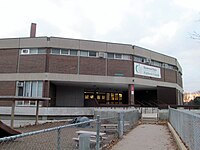
|
| J. S. Woodsworth Senior Public School | 1968 |
|

|
| J.B. Tyrell Senior Public School | 1973 | Named after geologist Joseph Tyrrell | |
| Jack Miner Senior Public School | 1970 | Named after naturalist and conservationist | |
| John McCrae Senior Public School | 1969 |
|

|
| Joseph Brant Senior Public School | 1969 |
|
|
| Joseph Howe Senior Public School | 1977 |
|
|
| Robert Service Senior Public School | 1971 | Named after poet Robert Service | 
|
| Samuel Hearne Senior Public School | 1971 | Named after explorer Samuel Hearne | 
|
| Scarborough Village Senior Public School | 1861 as S.S. No. 9 |
|

|
| Sir Alexander Mackenzie Senior Public School | 1972 | Named for explorer Alexander Mackenzie | 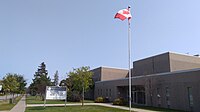
|
| Sir Ernest MacMillan Senior Public School | 1981 | Named after Ernest MacMillan | |
| Tecumseh Senior Public School | 1968 | Named for Tecumseh | 
|
| Wendell Statton Senior Public School | 1973 |
|

|
Secondary schools
[edit]Collegiate institutes
[edit]| Name | Opened | Notes | Image |
|---|---|---|---|
| Agincourt Collegiate Institute | 1915 | Formerly Agincourt Continuation/High School | 
|
| Alternative Scarborough Education 1 | 1975 | Shared space with St. Andrews PS | |
| Delphi Secondary Alternative School | 1981 | Alternative Scarborough Education 2 – located a Chartland PS | |
| Dr. Norman Bethune Collegiate Institute | 1979 | named after surgeon Dr Norman Bethune | |
| Birchmount Park Collegiate Institute | 1964 | ||
| Albert Campbell Collegiate Institute | 1976 |
|
|
| Cedarbrae Collegiate Institute | 1961 | 
| |
| Winston Churchill Collegiate Institute | 1954 | Named after British PM | 
|
| R. H. King Academy | 1922 |
|

|
| L'Amoreaux Collegiate Institute | 1973 | Named for settler family | |
| Sir Wilfrid Laurier Collegiate Institute | 1965 | Named for former PM Wilfrid Laurier | |
| Stephen Leacock Collegiate Institute | 1970 | Named for writer Stephen Leacock | |
| Sir John A. Macdonald Collegiate Institute | 1964 | Named after former PM John A. Macdonald | |
| Midland Avenue Collegiate Institute | 1962 | Closed 2000 and became Bond Academy until 2010 | 
|
| Sir Oliver Mowat Collegiate Institute | 1970 | Named for former Premier Oliver Mowat | |
| Lester B. Pearson Collegiate Institute | 1978 | Named for former PM Lester B. Pearson | |
| W. A. Porter Collegiate Institute | 1958 |
|

|
| Scarborough Centre for Alternative Studies | 1986 | Moved to former Midland CI site 2010 | |
| David and Mary Thomson Collegiate Institute | 1959 |
|
 
|
| West Hill Collegiate Institute | 1955 | 
| |
| Wexford Collegiate Institute | 1965 | ||
| Woburn Collegiate Institute | 1963 | 
| |
| South East Year Round Alternative Centre | 2005 |
|
Vocational schools
[edit]The SBE operated six vocational secondary schools that are not classified as regular collegiates. Three schools offered general and basic courses as Business and Technical Institute (formerly Secondary School) while the other three offered basic level courses in a special education level branded as High School (previously known as Vocational School).
Two facilities that have other unique features such as Bendale (swimming pool) and Tabor Park (child care).
| Name | Opened | Notes | Image |
|---|---|---|---|
| Bendale Secondary School | 1963 |
|

|
| Maplewood Vocational School | 1967 |
|

|
| Sir Robert L. Borden Secondary School | 1966 |
|

|
| Sir William Osler Vocational School | 1975 |
|

|
| Tabor Park Vocational School | 1965 |
|

|
| Timothy Eaton Secondary School | 1971 |
|

|
Core holdings and leased schools
[edit]Three former SBE have been lease out:
- In 1989, the then Scarborough Board of Education leased Tabor Park Vocation School (High School) to the Metropolitan Separate School Board (now the Toronto Catholic District School Board) and now operates as St. Joan of Arc Catholic Academy.
- McCowan Road Junior Public School opened 1954 was closed in 2011 and is leased out to UMC High School.[31] It was previously occupied by Wali Ur Asr Islamic School.
- Gooderham Public School (1955–1999) is now Gooderham Adult Learning Centre via leased to the City of Toronto.
Directors of Education
[edit]- Reginald H. King (1896–1962) 1954–1960
- Anson S. Taylor (1918–2007) 1961–1977
- Bill Parish (1924–2018) 1977–1982
- Pat McLoughlin 1982–1986
- Cameron A. Cowan 1986–1992
- Earl G. Campbell 1992–1998
Facilities
[edit]The board's administrative offices were located at 140 Borough Drive within the Scarborough Civic Centre. Buses and board vehicles were later stored on McLevin Avenue (McGriskin). The administrative offices remain in use today by the Toronto District School Board.
Until 1973, the board offices was also located at Scarborough Municipal Offices at 2100 Eglinton Avenue near Birchmount Road (built after World War II now demolished and site of parking lot). The new SBE administrative offices, located at 2466 Eglinton Avenue East (northside of Eglinton and west of Midland Avenue) and designed by architect Harold Carter, were built in 1954 and administrative operations were relocated in 1973. The former building was declared redundant by 1986 and was replaced by Rainbow Village condos in 1990.[32]
The board operated a fleet of their own school buses, similar to the Toronto Board of Education and Board of Education of North York and were stored at 2466 Eglinton Avenue East site.
Hillside Outdoor Education Centre, formerly Hillside PS (SS No 4), was used for outdoor education programs and located near Rouge Park and still used as such by the TDSB.
References
[edit]- ^ "Introduction". Dec 3, 1998. Archived from the original on 1998-12-03.
- ^ "Walk of Fame 2009 - Dr. R. H. King (1896-1962)". Archived from the original on 2011-10-03. Retrieved 2011-07-10.
- ^ a b c d e f g h i j k l m Bonis, Robert R. A History of Scarborough (1968)
- ^ Boyle, Theresa. "Adult education centre will be constructed at Centennial College." Toronto Star. January 23, 1992. Scarborough/Durham SD p. 4. Retrieved on October 8, 2013.
- ^ Deverell, John. "'One-stop' career training centre." Toronto Star. January 27, 1994. Scarborough/Durham SD p. 3. Retrieved on October 8, 2013.
- ^ Josey, Stan. "Class for suspended students on hold Community concern about program voiced at meeting." Toronto Star. June 30, 1994. Scarborough/Durham SD p. 6. Retrieved on October 8, 2013.
- ^ Behiels, Michael D. La francophonie canadienne: renouveau constitutionnel et gouvernance scolaire (Issue 12 of Collection Amérique française, ISSN 1480-4735). University of Ottawa Press, 2005. ISBN 2760306003, 9782760306004. p. 133. "Le Conseil des écoles françaises de la communauté urbaine de Toronto (CEFCUT), le 1er décembre 1988, s'établit dans un climat beaucoup moins acrimonieux qu'à Ottawa-Carleton. Jusqu'en 1987, les conseils scolaires de Toronto, North York et Scarborough ainsi que leurs CCLF gèrent les classes et les écoles de langue française qui accueillent près de 1700 élèves."
- ^ "Walter Perry Junior Public School". www.tdsb.on.ca.
- ^ "Info" (PDF). orporate.pickering.ca. Retrieved 2021-04-05.
- ^ "Anson Taylor spearheaded Scarborough school building boom". Toronto.com. Jul 12, 2007.
- ^ "JA Leslie".
- ^ "Hillside | Scarborough Historical Society".
- ^ "Scarborough Junction | Scarborough Historical Society".
- ^ "L'Amoreaux | Scarborough Historical Society".
- ^ "Wexford Public School". www.tdsb.on.ca.
- ^ "Wexford | Scarborough Historical Society".
- ^ "Info" (PDF). orporate.pickering.ca. Retrieved 2021-04-05.
- ^ "Ellesmere | Scarborough Historical Society".
- ^ "Toronto Architectural Conservancy - TO Built = General Crerar Public School". www.acotoronto.ca.
- ^ "Toronto Architectural Conservancy - TO Built = Hunter's Glen Junior Public School". www.acotoronto.ca.
- ^ "Babysitting Scarborough (Agincourt) M1S, and parents seeking childcare". topnanny.net.
- ^ "Pringdale Gardens Junior Public School" (PDF). tdsb.on.ca. Retrieved 2021-04-05.
- ^ "apps/school landing page/pdfs/web/4378". Archived from the original on 2020-06-22. Retrieved 2020-10-30.
- ^ "Bellmere Junior Public School". www.tdsb.on.ca.
- ^ "William Tredway Junior Public School" (PDF). tdsb.on.ca. Retrieved 2021-04-05.
- ^ "Woburn Junior Public School". www.tdsb.on.ca.
- ^ "George B Little Public School". www.tdsb.on.ca.
- ^ "Regent Heights Public School > About Us > History". schoolweb.tdsb.on.ca.
- ^ "J G Workman Public School". www.tdsb.on.ca.
- ^ "Secondary Schools." Toronto District School Board Scarborough Division. December 2, 1998. Retrieved on November 13, 2010.
- ^ "Home". UMC High School.
- ^ https://dalspace.library.dal.ca/bitstream/handle/10222/74682/RAIC_vol34_no11_access.pdf?sequence=1&isAllowed=y [bare URL PDF]
External links
[edit]- Scarborough Board of Education (Archive)

